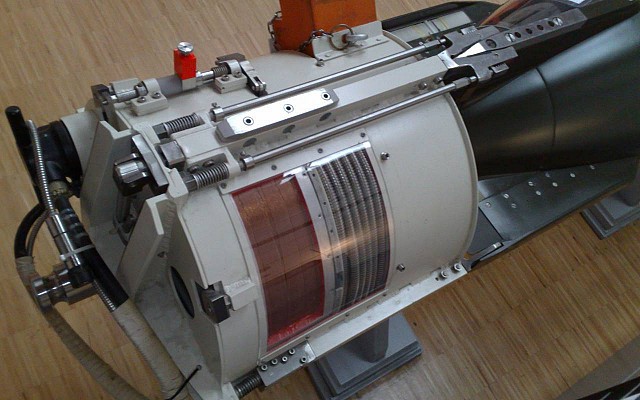DM2 Seeaal
DM2A1
Overview

SST-4
A number of Argentine navy SST-4 torpedoes in a storage rack. These are outwardly similar to the German DM2A1 Seeaal torpedo.
Source: Fuerzas de Defensa Argentinas -
© Copyright lies with original owner
1976 for DM2A1
Seeaal (also written Seal), German for "sea eel"
Description
Introduction
The DM2 Seeaal is a late Cold War era heavyweight torpedo of West German origin. This torpedo was developed for use against surface vessels and is launched from both submarines and fast attack craft. The DM2 is derived from the DM1 torpedo, with development timeframes overlapping. The DM2 in turn can be seen as the basis for the SST-4 and SUT torpedoes developed for export sales. It also forms the basis of the DM2A3 upgrade, which is described separately.
Design
The DM2 has various parts in common with the shorter DM1 Seeschlange which is intended for use against submarines. the DM2 is a wire guided torpedo with a horizontal scanning seeker head for use against surface vessels. It uses counter-rotating propellers and is driven by an electric motor. It has two battery compartments whereas the DM1 only has one, making the DM2 longer. The DM2 also features a heavier warhead since it is intended for use against frigates and destroyers. A distinct feature is that one surface vessels it is launched over the stern towards the rear with the tail facing forward.
Variants
Guidance
The DM2 is a wire guided torpedo with passive acoustic homing. Wire guidance is particularly useful in shallow water, where sonar ranges are reduced due to surface and bottom echoes. The wire guidance also provides a degree of standoff range, increasing survival rate of both submarines and fast attack craft that launch the DM2. Wire-guidance brings the torpedo towards the target area. Passive homing and optional active homing are used to find and guide towards the target.
Firepower
The DM2 has a 250 kg warhead which is equivalent to 450 kg TNT. A magnetic proximity fuse makes the torpedo explode below the keel. An impact fuse is also present. The DM2 has three selectable speed settings of 35, 23 and 18 knots. At maximum speed the range is up to 13 km. Maximum range of over 20 km is achieved at a lower speed setting.
Users
The DM2 was acquired by the West German navy and introduced in 1970. It is used both on submarines and fast attack craft, such as the Type 142 Zobel class (after 1970 refit) and Type 143 Albatross class. The DM2 was not to be exported. The SST-4 and SUT torpedoes are dedicated export designs that incorporate many features of the DM2. These were exported in large numbers.



